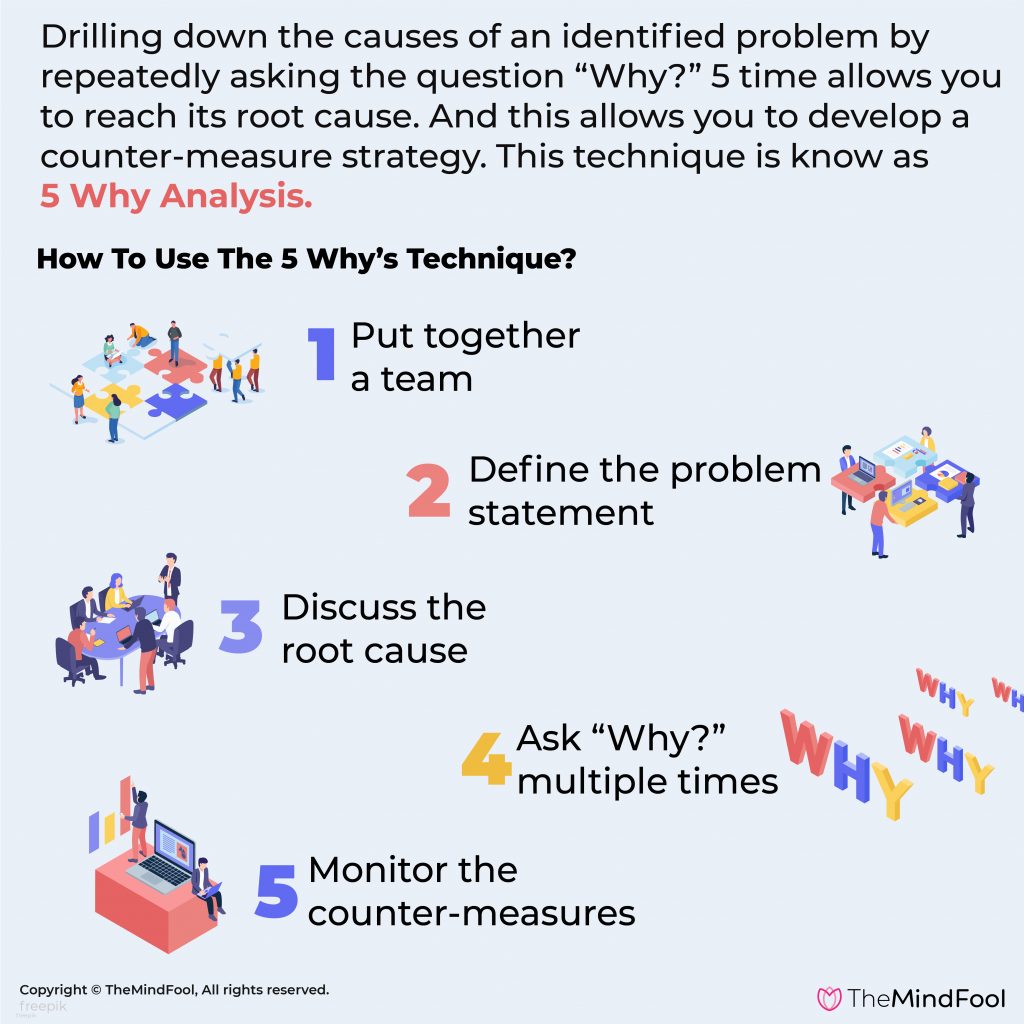
In these fast-paced times that we live in, it can seem like there’s no end to dearth of problems we face on a regular basis. Problems creep their way into our lives and leave us grappling to no end most times. Be it work-related, family-related or self-related! Problems are often symptoms of a deeper underlying issue. And many of our problems may get solved by quick solutions. But without tending to the deeper cause, these problems can recur.
Moreover, we get so involved fixing the surface cause, reaching the root cause never even occurs to us. And even if it does, we are not sure how to reach the root cause of a problem. Are you looking for a tool to take care of your recurring problems once and for all? Then, the 5 Why analysis is an excellent one.
The 5 Whys technique is an effective method to determine the root cause of recurring problems. The question “Why?” is repeated to zero in on the root cause.
5 Why Analysis – The Origin
SUMMARY
Sakichi Toyoda designed the 5 why method. The employees of the Toyota production system used it as a problem-solving tool.
Sakichi Toyoda designed the 5 whys process as an important problem-solving technique. Subsequently, the Toyota Motor Corporation implemented it. The process made its mark during the induction of the Toyota production system. People around the world have adopted this as a scientific approach to solve problems.
Taiichi Ohno, the architect of the Toyota Production System, described the method as, “The basis of Toyota’s scientific approach by repeating why five times… The nature of the problem, as well as its solution, becomes clear…”.
What Is The ‘5 Why Analysis’ Method?
SUMMARY
Drilling down the causes of an identified problem by repeatedly asking the question “Why?” allows you to reach its root cause. And this allows you to develop a counter-measure strategy.
The 5 Whys analysis is quite simple. One can use this approach, whether in a team or a group or by themselves. So, whenever a problem comes to attention, you come down to its root cause by asking “Why?” five times.
Repeating the question does not have to be exactly five times. It can be less or more than five based on the problem at hand. But studies show that five whys are enough to close the root cause analysis of the problem statement.
TIP
The effectiveness of this technique depends on the person/s involved. Above all, their ability to keep their answers logical and not emotional.
Emotionally driven answers/excuses can help in diffusing the problem. But providing a quick fix is a temporary solution. However, if you wish to never have to face that problem again, it’s important to answer with logic. Then you will be able to tackle the problem completely from its roots.
Once you identify the root cause, you can use that information to develop countermeasure strategies. This allows you to avoid the problem from repeating in the future.

How To Use The ‘5 Why Analysis’ Method?
SUMMARY
Form a team of stakeholders and start with defining the problem statement in a focussed concise manner. Then ask the question “Why?” 5 times until the root cause is deduced. Discuss the root cause to come up with counter-measures. These need to be implemented and monitored across the team to avoid the problem from recurring again.
1. Put together a team

Bring together a team of representatives from different departments. It’s important that every team member has good proficiency to understand the issue. So, ensure that they are familiar with the process in question. Especially about their department. Further, choose one neutral person as the facilitator. Their role is to ensure that the line of process is not disturbed by answers driven by emotions.
2. Define the problem statement

Discuss the issue at hand with all team members. Then arrive at a clear, concise and focused problem statement. The facilitator has to ensure that the problem statement is not too broad. Because this can make it difficult to reach the root cause within the time available.
3. Ask “Why?” many times

Once you define the problem statement, the facilitator should ask the first “Why?” to the team members. Most importantly, the facilitator should ensure that the answers are factual. And based on actual happenings or existing data. Discourage assumptions, emotional opinions, personal excuses, and guesswork. Because they can lead to many causes and create more confusion.
Ask the next question only once the first round of answers turn out to be logical and helpful for the process. The facilitator may write the answers on the whiteboard in crisp sentences. They will repeat this process five times or as many times as necessary. Until you figure out the root cause of the problem.
TIP
Some problem statements can have more than one root cause. In such cases, repeat the method by asking a different line of questions each time. Record every root cause to work on. This method is particularly useful to figure out organizational loopholes and process defects.
4. Discuss the root cause

After detecting the root cause of the problem statement, decide the corrective actions. And, take inputs from all team members. Because suggestions from all departments increase the effectivity of the corrective actions. Then note down the counter-measures and pass on to all concerned departments. Finally, put them to immediate action to avoid the problem from recurring.
TIP
Counter-measure strategies intend to improve the situation. It has no place for blame-placing or finger-pointing. Counter-measures are very different from solutions. Solutions offer a temporary fix of the effect without addressing the cause. Whereas counter measures suggest corrective actions so that the problem never occurs again.
5. Monitor the counter-measures

It’s ideal to appoint a team member to track the implementation across all departments. And also to observe the process. Schedule meetings periodically to discuss the impact of the counter-measures taken. If they don’t seem to be giving the desired results, repeat the 5 Why analysis.
5 Why Analysis Example
Below is an example of a real life problem that has been solved with the 5 whys analysis. The cause and effect relationship of the problem becomes clear with this example.
Problem Statement: My boss fired me!
- Why? [Why did my boss fire me?]
I was late to work multiple times over the past few months.
2. Why? [Why was I late to work?]
My child has been having difficulty waking up and she is always late for school.
3. Why? [Why was she not able to wake up on time?]
She is up late finishing up her homework.
4. Why? [Why was she not finishing the homework on time?]
She has difficulty understanding and writing words.
5. Why? [Why was she having the difficulty?]
She is dyslexic.
5 Why Analysis Template
If you are looking for a layout to easily analyse your problem and get to the solution, here is a 5 whys template for you. The root cause of your problems will be clearly identified with this template. The template presents a structured approach to identify the root.
Here is an sample template –
Closing Thoughts
Often the real cause of every problem is not found on the surface. You find them only after digging deep into the issue. Therefore, we spend so much time fixing the surface cause. And then wondering why the problems don’t stop recurring in spite of all the efforts we put in.
To sum up, the only way for the problem to stop repeating is to nip it in the bud. In other words, finding the root cause and taking counter-measures can be effective in such scenarios. Hence, the 5 Why analysis is one of the most effective interrogation techniques you can adopt. Above all, with an awareness of tools like this, we can put an end to many problems in this world, one problem at a time!
Pranita loves words! She has spent most of her childhood and adult life reading and writing. So it wasn’t a surprise when she quit her corporate IT job within a year to pursue her career as a writer. In her 7+ years into the field of content writing, she has worked on various niches. Psychology, mental health, spirituality, health & wellness, fashion, and food are her favorite ones. Pranita says that it’s every writer’s hope that their words survive longer than they do. So she hopes her words continue to light up other readers' path like so many writings have lit her’s. At The Mindfool, she is happy to be contributing to articles that have the power to make a positive difference in people's lives.
